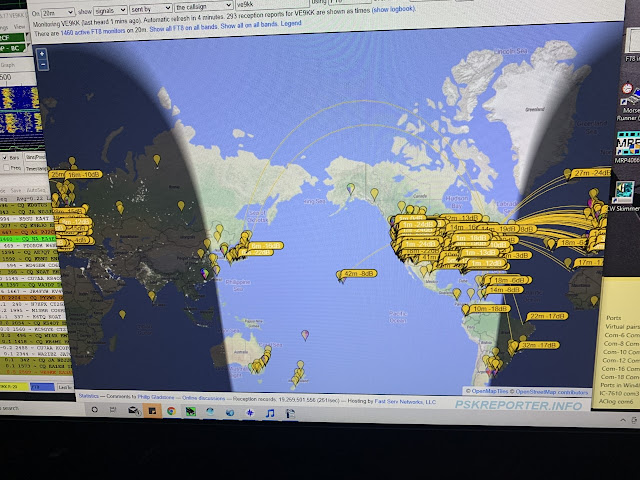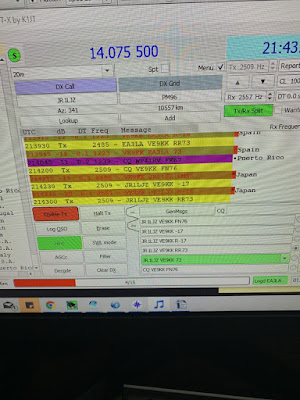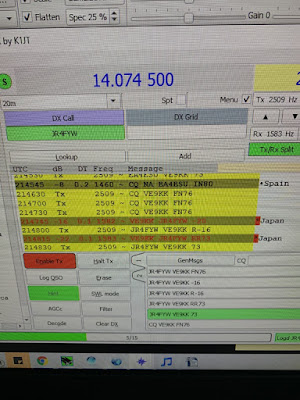 LHS Episode #404: The Weekender LXIX
LHS Episode #404: The Weekender LXIX
It's time once again for The Weekender. This is our bi-weekly departure into the world of amateur radio contests, open source conventions, special events, listener challenges, hedonism and just plain fun. Thanks for listening and, if you happen to get a chance, feel free to call us or e-mail and send us some feedback. Tell us how we're doing. We'd love to hear from you.
73 de The LHS Crew
Russ Woodman, K5TUX, co-hosts the Linux in the Ham Shack podcast which is available for download in both MP3 and OGG audio format. Contact him at [email protected].
 A nice FT8 afternoon.
A nice FT8 afternoon.
I was on the radio this afternoon and decided to give FT8 a try on 20 meters. I made some contacts in the U.S., France, Germany and Spain. Then out of the blue, I had a station from Japan call me and I did not notice any J stations I was decoding but I was very pleased regarding the contact. Then once again out of nowhere another J is calling me and I made my second contact. I took a look at PSK reporter to see where my FT8 signal was being spotted. I was shocked to see not only Japan but also Hawaii. A very nice time on the radio today.
Mike Weir, VE9KK, is a regular contributor to AmateurRadio.com and writes from New Brunswick, Canada. Contact him at [email protected].
 UK Regulator Ofcom Releases Ham Licenses By Age: Compares Favorably with US Estimates
UK Regulator Ofcom Releases Ham Licenses By Age: Compares Favorably with US Estimates
In response to a Freedom of Information Act, the United Kingdom amateur radio license regulator, Ofcom, has released counts of ham licenses by age group (see here). The ICQ Podcast covered this story in this week’s episode. They are simple counts but I’ve taken them and added UK population data for comparison. Using a graph from my recent NCJ article on aging in American radiosport, I also make general comparisons to the US ham population. How does the UK compare to the US in terms of the age distribution relative to the overall population? Are hams becoming more elderly? Is there an influx of younger people into amateur radio in these two countries? The results are concerning to anyone interested in the long term viability of amateur radio in either country.
The bar chart shows the three UK license classes—Foundation, Intermediate, and Full—with the corresponding total UK population by age group. These categories are what the Ofcom report contains so I was unable to reconfigure it for other groupings. The purple total population bar in comparison to any of the ham licenses illustrates the “aging” of the British ham population. This is especially the cast for Full licenses. As the age group enters mid-life (post-50), the imbalance becomes clear and gets more imbalanced as age increases.
The second bar chart is from my NCJ article on US hams. The ARRL membership data are proxies for the US FCC ULS license database. (The FCC stopped collecting birth year some decade or so ago.) The tan bar is the total population from the Census Bureau. The green bar is from an ARRL survey of current and previous NCJ subscribers and are a proxy for contest participants.
Clearly, the US amateur radio population compares favorably with those in the UK as represented in the Ofcom data release. There may be a slightly more aging pattern in the US data. It’s the post-60 year old category where the ham population surpasses the comparable share of the total population. As noted in my NCJ article, the contesting data show that this group is even more elderly than hams in general.
Ofcom is an evidence-based regulator, so market research is important to us. Many of our decisions are informed by research evidence, and our market research ensures that we have a thorough, robust and up-to-date understanding of consumers in the UK.
Source: https://www.ofcom.org.uk/research-and-data/about-ofcoms-research
These data released by Ofcom show a revealing, but not entirely surprising, picture of the amateur population in the United Kingdom. Most would agree that they “see” hams at rallys and elsewhere and most “look older” than “younger.” In these data, there are younger hams in the data but they are indeed smaller in number and share. But until we have actual data on all licensed hams (and even the Ofcom release warns about their under-coverage), it’s like building the proverbial dinosaur from some bones discovered in an archaeological dig from one site. We also do not know about how many “late-in-life” hams will emerge during their mid to later years (see here for survey estimates). By inference, the hypothesis that amateur radio is a cultural phenomenon mostly engaged in members of the the Western “Baby Boom” (see here) is not inconsistent with these data. Until we have data where longitudinal and age-cohort variables are measured will we even begin to be able to move beyond the ubiquitous: “well, the blokes at the rally…” or “in my club, I’m the youngest and I’m 50 years old”. Those comments may indeed be characteristics of the full ham population, but we simply do not know this for sure or with any precision.
Even though Ofcom says it’s an evidence-based regulator, until more data like this is released and analyzed, we won’t be able to really get a handle on social change in the hobby and public serve of ham radio. Age and cohort comparisons (e.g., Glenn, Cohort Analysis) are the standard to measure change like this. In the US, the FCC isn’t even in the ball game. Sad.
Frank Howell, K4FMH, is a regular contributor to AmateurRadio.com and writes from Mississippi, USA. Contact him at [email protected].
 LHS Episode #403: MVoice and MRefD Deep Dive
LHS Episode #403: MVoice and MRefD Deep Dive
Welcome to the 403rd installment of Linux in the Ham Shack. In this episode, the hosts bring in guest Tom early, N7TAE. Tom is the creator and lead developer in the MVoice and MRefd projects. MVoice is the original M17 client software and MRefD is a spinoff of XLXD which creates software reflectors for the M17 voice protocol. We take an in-depth look at how each piece of software was developed and written. Then from a user perspective we detail downloading, building, configuring and running each project. Thanks for listening and have a great week.
73 de The LHS Crew
Russ Woodman, K5TUX, co-hosts the Linux in the Ham Shack podcast which is available for download in both MP3 and OGG audio format. Contact him at [email protected].
 ICQ Podcast Episode 347 – RSGB Q1 Review and Radio Scouting
ICQ Podcast Episode 347 – RSGB Q1 Review and Radio Scouting
In this episode, Martin (M1MRB) is joined by Leslie Butterfield G0CIB, Dan Romanchik, KB6NU, Matthew Nassau M0NJX and Edmund Spicer M0MNG to discuss the latest Amateur / Ham Radio news. Colin (M6BOY) rounds up the news in brief and in this episode we have a double feature RSGB Quarter 1 Update and Scouting Radio.
ICQ AMATEUR/HAM RADIO PODCAST DONORS
We would like to thank Michael Bridak (K6GTE), Christopher Naylor (VK3TLA) and our monthly and annual subscription donors for keeping the podcast advert free. To donate, please visit - http://www.icqpodcast.com/donate
- Ofcom Released Age of Radio Amateurs Data - Modified French Amateur Radio Callsign for Great Britain Nationals - Cooperative Effort to Resolve Potential 70-Centimetre Interference Issue - New RSGB EMF Calculator Available - 4M IRTS News in the East Leinster region - Resuming UK Examinations in Clubs - Ham Radio Friedrichshafen Physical Event Cancelled
Colin Butler, M6BOY, is the host of the ICQ Podcast, a weekly radio show about Amateur Radio. Contact him at [email protected].
 Ham College 75
Ham College 75
Ham College episode 75 is now available for download.
Extra Class Exam Questions – Part 13.
E3B Transequatorial propagation, long-path, grayline, ordinary and extraordinary waves, chordal hop, and sporadic E mechanisms.
55:06
George Thomas, W5JDX, is co-host of AmateurLogic.TV, an original amateur radio video program hosted by George Thomas (W5JDX), Tommy Martin (N5ZNO), Peter Berrett (VK3PB), and Emile Diodene (KE5QKR). Contact him at [email protected].
 Hunting For NDBs In CLE266
Hunting For NDBs In CLE266
Propagation on MF has been both hot and cold for the past few weeks, seemingly depending on where you live and the amount of geomagnetic activity affecting your region.
A 'challenge target' for listeners in North America is YZS - 362kHz in Coral Harbour, NU, on Southampton Island at the north end of Hudson Bay. It's widely heard throughout North America and Europe and is a good target for listeners everywhere. Listen for YZS's upper sideband on 362.405 kHz.
When tuning for NDBs, put your receiver in the CW mode and listen for the NDB's CW identifier, repeated every few seconds. Listen for U.S. NDB identifiers approximately 1 kHz higher or lower than the published transmitted frequency since these beacons are modulated with a 1020 Hz tone approximately.
For example, 'AA' near Fargo, ND, transmits on 365 kHz and its upper sideband CW identifier is tuned at 366.025 kHz while its lower sideband CW ident can be tuned at 363.946 kHz. Its USB tone is actually 1025 Hz while its LSB tone is 1054 Hz.
Often, one sideband will be much stronger than the other so if you don't hear the first one, try listening on the other sideband.
Canadian NDBs normally have an USB tone only, usually very close to 400 Hz. They also have a long dash (keydown) following the CW identifier.
All NDBs heard in North America will be listed in the RNA database (updated daily) while those heard in Europe may be found in the REU database. Beacons heard outside of these regions will be found in the RWW database. These databases have recently been re-vamped and are slicker than ever before!
From CLE coordinator Brian Keyte (G3SIA), comes the following CLE info:
Hello all
Our 266th Co-ordinated Listening Event is almost here.
Can new 'listening eventers' join in too? YES, PLEASE!
Joachim and I are always pleased to help first-time CLE logs
through the harvester program.
Days: Friday 26 March - Monday 29 March
Times: Start and End at midday, your LOCAL time
Range: 350.0 - 369.9 kHz
Please log all the NDBs you can identify that are listed in this range (it includes 350 kHz but not 370) plus any UNIDs that you come across there.
You can find full information to help you, including seeklists made from
REU/RNA/RWW, by going to the CLE page http://www.ndblist.info/cle.htm and clicking on CLE SEEKLIST there.
Please send your 'Final' CLE log to the List, if possible as a plain text
email and not in an attachment and - important - with 'CLE266' and 'FINAL'
in its title.
Please show the following main items FIRST on EVERY line of your log:
# The full Date (e.g. 2021-03-26) or just the day (e.g. 26)
and UTC (the day changes at 00:00 UTC).
Many of us will be changing our house clocks during
the weekend, but UTC CONTINUES UNCHANGED.
# kHz - the beacon's nominal published frequency, if you know it.
# The Call Ident.
Optional details such as Location and Distance go LATER in the same line.
Please always include details of your own location and brief details of the
receiver, aerial(s) and any other equipment you were using.
Joachim or I will send the usual 'Any More Logs?' email at about 19:00 UTC
on Tuesday so you can check that your log has been found OK.
Make sure that your log has arrived at the very latest by 08:00 UTC on
Wednesday 31 March. We hope to make all the combined results within a day
or so.
Good listening
Brian
-------------------------------------------------------------------
From: Brian Keyte G3SIA ndbcle'at'gmail.com
Location: Surrey, SE England (CLE coordinator)
-------------------------------------------------------------------
If you are interested in some remote listening - maybe due to local difficulties - you could use any one remote receiver for your loggings, stating its location and with the owner's permission if required.( e.g. see kiwisdr.com ) A remote listener may NOT also use another receiver, local or remote, to make more loggings for the same CLE.
These listening events serve several purposes. They
• determine, worldwide, which beacons are out-of-service or have gone silent since the last CLE covering this range
• will indicate the state of propagation conditions at the various participant locations
• will give you an indication of how well your LF/MF receiving system is working
• give participants a fun yet challenging activity to keep their listening skills honed
Final details can be found at the NDB List website, and worldwide results, for every participant, will be posted there a few days after the event.
The NDB List Group is a great place to learn more about the 'Art of NDB DXing' or to meet other DXers in your region. There is a lot of good information available there and new members are always very welcome. As well, you can follow the results of other CLE participants from night to night as propagation is always an active topic of discussion.
You need not be an NDB List member to participate in the CLEs and all reports, no matter how small, are of much value to the organizers.
Remember - 'First-time' logs are always VERY welcome!
Reports may be sent to the NDB List Group or e-mailed to CLE co-ordinator, Brian Keyte (G3SIA), whose address appears above. If you are a member of the group, all final results will also be e-mailed and posted there.
Please ... give the CLE a try ... then let us know what NDB's can be heard from your location! Your report can then be added to the worldwide database to help keep it up-to-date.
Have fun and good hunting!
Steve McDonald, VE7SL, is a regular contributor to AmateurRadio.com and writes from British Columbia, Canada. Contact him at [email protected].




















